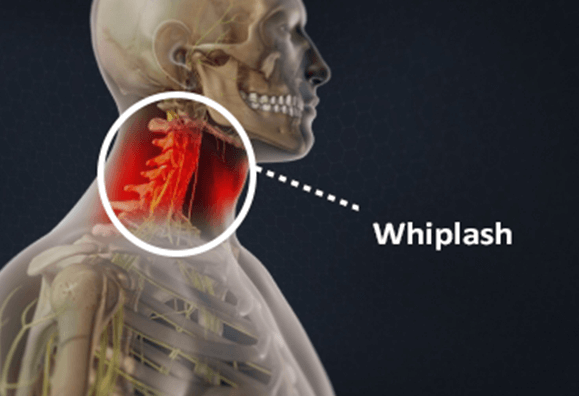What is Whiplash?
Whiplash is an imprecise term for injury to the cervical vertebrae and adjacent soft tissues. This injury is produced by a sudden jerking or backward & forward acceleration of the head with respect to the vertebral column. This motion causes a hyperextension the neck beyond its normal range of motion damaging muscle, ligaments and connective tissue. People in a vehicle that is suddenly and forcibly struck from the rear may sustain “whiplash” injuries.

According to the National Safety Council, the most common forms of whiplash, which are neck sprains and neck strains, account for almost 10% of all motor vehicle accidents in which long-term disability occurs.
Causes of Whiplash?
The most common whiplash injuries occur when a motor vehicle is struck from behind. This causes the occupant’s body to thrust forward as the head snaps back and forth until the chin strikes the chest. This violent motion can happen several times in quick succession, inspiring the descriptive term “whiplash.”
Although front-end and side collisions wrench the head and neck in different ways, they can produce similar neck sprains. These motions can hyperextend the neck beyond its normal range of motion, damaging muscle, ligaments, connective tissue and other structures.
Prior to 1969, when headrests became standard equipment in cars, there was nothing to limit back-and-forth head movement in a rear-end collision. Although properly positioned headrests can reduce the risk of neck pain after rear-end collisions, these injuries still occur.
Symptoms of Whiplash
Researchers have identified a broad spectrum of injuries and symptoms associated with whiplash. Soft tissues such as muscles and ligaments cause pain because they have been stretched beyond their normal limits. On occasion, they may bleed or even tear. Violent whiplash motion can squeeze the disks of the cervical spine so hard that they herniate and press on a nerve. Spinal vertebrae are sometimes knocked painfully out of alignment.
The most common form of whiplash injury is neck strain that manifests as temporary pain and stiffness. One may not feel significant discomfort until several days after the accident. The pain may gradually intensify, moving to the back of the head, chest muscles, shoulders and upper arms. The person may complain of hoarseness and have difficulty in swallowing. The neck typically feels tender, swollen and hurts when turned from side to side.
Some people also experience muscle spasms. Those who sustain head injuries may have episodes of blurred vision, ringing or buzzing in the ears and dizziness.
More serious injuries may involve damage to blood vessels, nerves or the spine.
Treatment for Whiplash
Mild cases of whiplash injury usually improve after a few days when treated with rest and anti-inflammatory medications. However, additional measures are required when the neck pain is constant, muscle spasms occur when the head is turned, or pain and spasms have spread to the shoulder and upper arm.
Patients are advised to wear a soft cervical collar to keep the neck from bending. The collar also takes weight off of the muscles. It should be worn intermittently instead of all the time to reduce dependency. It is especially helpful in settings where pain is most likely to occur, such as driving or riding in moving vehicles.
Some doctors recommend taking it easy during the first two weeks after the accident, but staying in bed is not necessary. It is appropriate to take short walks and to go to work for a few hours or more each day, if the job does not put much stress on neck and shoulder muscles.
When whiplash injury is not severe, physicians may provide patients at-home exercises designed to strengthen and increase the flexibility of the neck muscles. If pain is severe or continuous, however, many doctors recommend working with a physical therapist or similar professional. First to learn to use undamaged muscles and ligaments and then to rehabilitate the injured ones.
Surgery for Whiplash
Following a motor vehicle crash, 15% to 40% of patients with acute neck pain develop chronic neck pain. Whiplash can cause injuries to joints, discs, spinal ligaments, cervical muscles and nerve roots. Conditions that often require surgery.
If treatment with medications, physical therapy and spinal injections have failed to relieve your pain, surgery may be necessary. The Bonati Spine Institute has helped thousands of patients find relief from their chronic pain.
The Bonati Spine Institute encourages patients with whiplash to contact us to request a no-obligation MRI review or discuss your conditions with our medical professionals. Find out why The Bonati Spine Procedures are considered to be among the world’s best solutions when it comes to advanced spine surgery. You don’t need to live with Pain.
Click here to watch patients talk about their experience with The Bonati Spine Institute!
